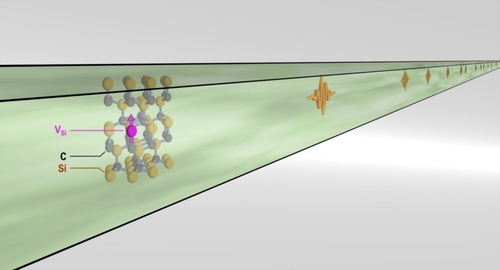INDUSTRY
Stuttgart researchers work on integrating color centers into nanophotonic silicon carbide structures
Research into superfast quantum computers is now well advanced, but it is not yet possible to connect the individual processors. An international research team with participation from the University of Stuttgart in Germany has now shown a way to scale quantum supercomputers using nanophotonic silicon carbide structures to solve the problems.
A promising route towards larger quantum computers is to orchestrate multiple task-optimized smaller systems. To dynamically connect and entangle any two systems, photonic interference emerges as a powerful method, due to its compatibility with on-chip devices and long-distance propagation in quantum networks.
One of the main obstacles towards the commercialization of quantum photonics remains the nanoscale fabrication and integration of scalable quantum systems due to their notorious sensitivity to the smallest disturbances in the close environment. This has made it an extraordinary challenge to develop systems that can be used for quantum supercomputing while simultaneously offering an efficient optical interface. 
A recent result shows how the integration obstacle can be overcome. The work is based on a multi-national collaboration with researchers from the Universities of Stuttgart in Germany (Physics 3), California - Davis, Linköping, and Kyoto, as well as the Fraunhofer Institute at Erlangen, the Helmholtz Centre at Dresden, and the Leibniz-Institute at Leipzig.
The researchers followed a two-step approach. First, their quantum system of choice is the so-called silicon-vacancy center in silicon carbide, which is known to possess particularly robust spin-optical properties. Second, they fabricated nanophotonic waveguides around these color centers using gentle processing methods that keep the host material essentially free of damage.
“With our approach, we could demonstrate that the excellent spin-optical properties of our color centers are maintained after nanophotonic integration,” says Florian Kaiser, Assistant Professor at the University of Stuttgart, the supervisor of this project. “Thanks to the robustness of our quantum devices, we gained enough headroom to perform quantum gates on multiple nuclear spin qubits. As these spins show very long coherence times, they are excellent for implementing small quantum computers.”
“In this project, we explored the peculiar triangular shape of photonic devices. While this geometry is of commercial appeal because it provides the versatility needed for scalable production, little has been known about its utility for high-performing quantum hardware. Our studies reveal that light emitted by the color center, which carries quantum information across the chip, can be efficiently propagated through a single optical mode. This is a key conclusion for the viability of integration of color centers with other photonic devices, such as nanocavities, optical fiber, and single-photon detectors, needed to realize full functionalities of quantum networking and computing.” – says Marina Radulaski, Assistant Professor at the University of California – Davis.
What makes the silicon carbide platform particularly interesting are its CMOS compatibility and its heavy usage as a high-power semiconductor in electric mobility. The researchers now want to benefit from these aspects to leverage the scalable production of spin-photonics chips. Additionally, they want to implement semiconductor circuitry to electrically initialize and read out the quantum states of their spin qubits. “Maximising electrical control – instead of traditional optical control via lasers – is an important step towards system simplification. The combination of efficient nanophotonics with electrical control will allow us to reliably integrate more quantum systems on one chip, which will result in significant performance gains.”, adds Florian Kaiser, “In this sense, we are only at the dawn of quantum technologies with color centers in silicon carbide. Our successful nanophotonic integration is not only an exciting enabler for distributed quantum computing, but it can also boost the performance of compact quantum sensors.”
